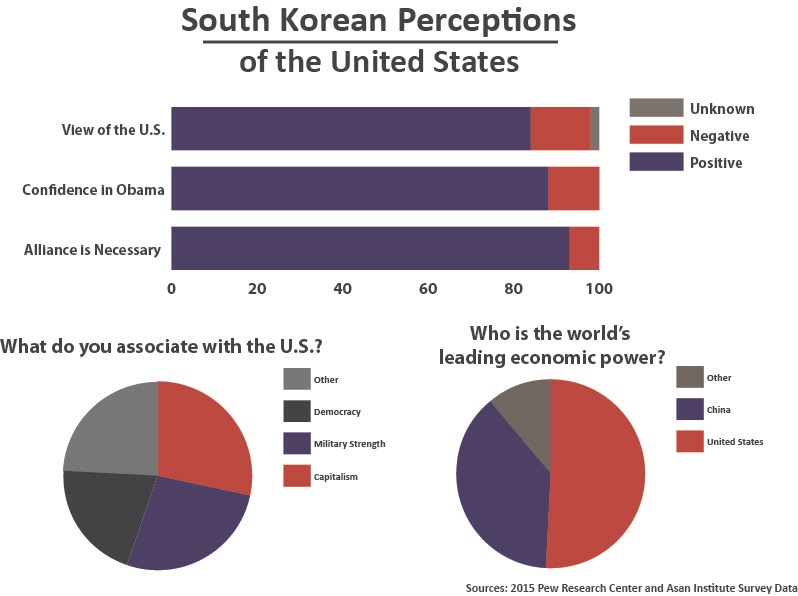The Peninsula
Trans-Pacific Love Affair: South Korean Perceptions of the United States on the Rise

By Jenna Gibson
According to at least one poll, South Korea has a higher opinion of the United States than the United States has of itself. In its 2015 Global Indicators survey, Pew Research Center found that 84 percent of South Koreans view the U.S. favorably, while only 83 percent of Americans said the same.[1] This is the highest approval rating for the U.S. within South Korea since Pew started collecting this data in 2002, when approval was only at 52 percent[2].
South Korea doesn’t only approve of the United States as a whole – they also have a positive view of its leader. When asked if they are confident in President Barack Obama to “do the right thing regarding world affairs,” 88 percent of Koreans answered affirmatively. The only country surveyed that has more confidence in Obama is the Philippines, with 94 percent.
This approval far outweighs even Korean views on their own government – a recent Organization for Economic Cooperation and Development (OECD) report found that only 34 percent of Koreans said they have confidence in their national government. And their perception of Obama certainly dwarfs his current 46 percent domestic approval rating.
Highs and Lows
South Koreans haven’t always been this keen on the United States. As recently as 2007, only 58 percent of those surveyed by Pew had favorable opinions about their ally. And going back to 2003, less than half responded positively (46 percent favorable).
What caused this significant shift in just over a decade? It’s important to keep context in mind. In 2002, tensions flared after an infamous incident where two Korean teenagers were killed after being struck by a U.S. military vehicle. The drop in favorable views of the United States in 2003 makes perfect sense in this context.
Further, lukewarm responses through the following decade can possibly be attributed to the Sunshine Policy, an attempt to influence North Korea using carrots rather than sticks. According to a Washington Post column, “The policy attempted to soften the tension between the two Korean nations, something that often required breaking, rhetorically or even politically, with the United States. President Roh Moo-hyun did this in part by criticizing the U.S. containment policy – and thus, implicitly, the enormous American military force stationed in his country – in an effort to demonstrate goodwill toward North Korea and, he hoped, to lay the groundwork for real cooperation.”
Since 2009, administrations in both the United States and South Korea have worked ensure that their policies towards North Korea are aligned and public perceptions have moved in a similar direction. In fact, a recent Washington Post article points out that younger South Koreans are among the most pro-American. One possible explanation – “they appear to be more suspicious about China’s rise and are way more suspicious of North Korea’s intentions. For both of these reasons, it’s understandable that they value the alliance with the United States.”
Interestingly, a 2015 poll by the Asan Institute found that South Koreans associated the United States most with capitalism (28.6 percent), military strength (26.7 percent), and democracy (20.6 percent). It follows, then, that when the two countries’ economic, military and diplomatic priorities align, as they generally do at the moment, public opinion will follow.
Korean perception of the United States can of course be lost in an instant, but it’s important to note that even during one of the lowest points in recent memory, more than half of the Korean people still viewed the U.S. favorably. These polls show the strength of the U.S.-Korea Alliance, even if the two countries don’t always see eye to eye. By keeping this in mind and building on this solid base of support, policymakers on both sides of the Pacific can continue to work together to address issues in Northeast Asia and beyond.
Jenna Gibson is the Associate Director for Communication Technology and Programs at the Korea Economic Institute of America. The views expressed here are the author’s alone.
Photo from Sue Langford’s photostream on flickr Creative Commons.
[1] Margin of error for South Korea: +/- 3.2 percent, for United States +/- 3.6 percent.
[2] In contrast, the United States’ other ally in the region, Japan, is less enthusiastic. Favorable views of the U.S. have slid over the past few years from an all-time high of 85 in 2011 to 68 percent in 2015.
